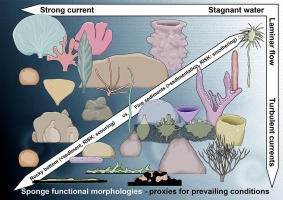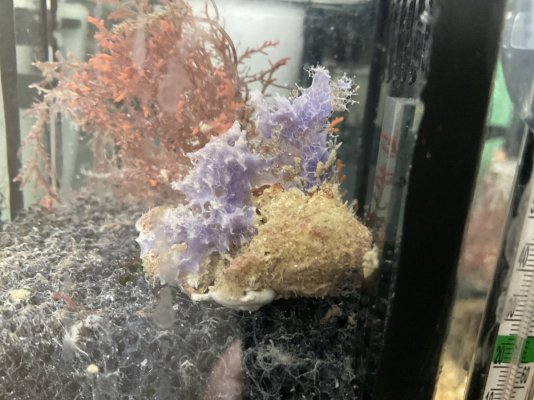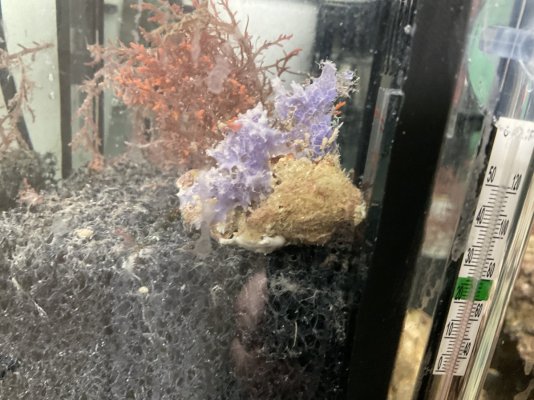Navigation
Install the app
How to install the app on iOS
Follow along with the video below to see how to install our site as a web app on your home screen.
Note: This feature may not be available in some browsers.
More options
You are using an out of date browser. It may not display this or other websites correctly.
You should upgrade or use an alternative browser.
You should upgrade or use an alternative browser.
Really pretty purple colored rubbery spiky thing. Is it a sponge??
- Thread starter ilovemarinetanks
- Start date
- Tagged users None
Neat...
If it is rubbery and Blue you DO NOT WANT IT!
Paul B. & I both had a heck of a time getting rid of it after it went crazy everywhere.
Hi snoopy, do you mind linking the thread you made where you posted about it previously? I can’t seem to find it.
This thing is definitely purple and not blue. Do you think it should still be removed?
I could be wrong (sponge ID isn't always straightforward), but I'd guess it's a Dysidea sp. sponge (some species/specimens are blue, others are purple) - if so, it's a harmless filter feeder; unlike the photosynthetic plating sponges Paul B. had in his tank (which are known for being invasive under good conditions), these kinds of sponges don't tend to do very well/last very long in our tanks.
Sponge info dump:
Sponge info dump:
For sponges, you need to position the specimen properly and feed the right kinds of foods in high enough quantities for them to survive (I don't know if I've heard of any non-invasive sponges actually thriving in a tank yet) - the main problem seems to be providing the right kinds of foods in sufficient quantities.
Long story short, the only "success" stories I've seen with sponges either come from labs (one of which was able to keep the sponges alive and healthy enough to reaggregate while also being somewhat unhealthy and clearly lacking in color by feeding a bunch of phyto while the sponges likely also fed on bacteria, cyano, and possibly diatoms in the tank; the other managed to keep a known invasive species of sponge alive in a similarly mildly healthy/unhealthy state, but I don't remember the methodology off the top of my head) or from people regularly stirring their sandbeds and/or blowing detritus off their rocks - this is thought to help get the bacteria, microalgae (phytoplankton and similar), and appropriately sized organic matter pieces from the sandbed/rocks into the water column for the sponges to feed on (these seem to have similar levels of success as the labs mentioned above, with periods of both sponge growth and sponge deterioration).
A massive sponge info dump (I’m sorry, it’s kind of daunting - I need to go through and organize/condense it one of these days):
The info I’ve compiled on sponges so far:
Most sponges that I’ve looked into primarily consume Dissolved Organic Matter (DOM - sometimes called Dissolved Organic Carbon, or DOC, which is actually a component of DOM) and specific kinds of bacteria (which kinds vary at least a little from one sponge to another). Most of them seem to have no preference for where their DOC comes from, but they have a preference for algal-derived Dissolved Organic Nitrogen (i.e. DON produced by algae). Giant Barrel Sponges and some Boring Sponges have had their diets analyzed, and they primarily consume DOM (~80% of their total diet, with the remaining ~20% coming from Particulate Organic Matter (POM - primarily phytoplankton and bacteria, though, as mentioned above, bacteria is taken in much higher quantities than phyto). This ratio of approximately 80/20 seems to be pretty typical(though it can vary from what I've seen by +/-15% or so one way or another) for most sponges from what I can find.
Unfortunately, we don’t have an easy, hobbyist way to measure DOM, DOC, DON, or POM (or POC or PON) that I’m aware of, so we don't really have any way to determine if the sponges are getting enough food consistently to thrive (to say nothing of measuring the amounts of specific bacteria in our tanks), but there you have it.
If you do some reading on sponge keeping here on R2R, you'll probably find pretty quickly that most people recommend low lighting low flow for sponges (exceptions for photosynthetic sponges), but the truth is this also depends on the sponge species. The most common photosynthetic sponges in the hobby are the photosynthetic plating sponges (like you can find/buy on LiveAquaria's site), but there are quite a few other sponges that are photosynthetic too (such as Aplysina cauliformis, for example), and these would benefit from high lighting. Similarly, some species of sponge do best in very high flow areas, including high flow areas with laminar flow (a lot of people talk about random flow on the site, which would be called turbulent flow, as they're trying to get the water moving basically randomly throughout the tank - laminar flow is just a continuous flow that doesn't change, so the water keeps going the same direction nonstop and there's nothing random about it). If you're not sure if the sponge is photosynthetic or not, you can try starting it in one lighting (such as low lighting), see how it does and then compare it to a different lighting (moderate or high) and figure out its needs from that. Same with the flow. Light will probably be the most important part for photosynthetic species and the food/flow the most important for NPS species - some people have found stirring up their sand to be an effective food source for sponges, likely because it puts bacteria and DOM into the water column. It’s probably safest to start low light/flow and move up, rather than starting high and moving lower.
Some sponges do well in some tanks but not in others for no discernible reason, and some some sponges travel well while other sponges don't. Plus, sometimes a sponge will basically disintegrate into a ton of tiny pieces and look like it's dying, but it'll then proceed to grow and live on afterwards. Similarly, some sponges grow invasively while others grow incredibly slowly, so a lot of keeping these guys at this point really just depends on the luck of the draw (so to speak).
Just a note here, some species of sponge (such as some Sycon spp. - pineapple sponges) do in fact eat noteworthy (for the sponge, not necessarily for the tank they're in) levels of small phyto species.
The only real advice I can offer for sure for this specific sponge (Clathria (Clathria) prolifera) is that it eats Isochrysis galbana (T-Iso),* so offering it some regularly may prove beneficial. Beyond that, it grows on solid surfaces (like rocks, dock pilings, etc.), it is often found in the intertidal zone, and it's said that it can handle high brackish salinities (reportedly as low as 15ppt).
https://www.researchgate.net/public...ge_Clathria_prolifera_from_the_Chesapeake_Bay
To add to the above, knowing that bacteria and DOC are important, some people might recommend carbon dosing and/or turning off a UV if you have one running so as to encourage bacterial population growth (you may need to be careful if you try this though, as too big of a bacteria bloom could cause issues in your tank).
For general sponge health, I've heard good things from people dosing ChaetoGro, and some phyto dosing and/or macro in the tank may help encourage sponge health/growth too.
Also, a couple of things pertaining to sponges and silicates - most sponges do need them, so it may be a good idea (as mentioned) to dose silicates if you're trying to promote sponge growth.
Should you decide to try and keep any of the sponges you're interested in, take note if you can of the sponge's surroundings and the flow it's in - if you can't do that, the link below may help you figure out sediment and flow preferences for any sponges you want to keep (the graphical abstract close to the top is a visual representation of the info presented).

No taxonomy needed: Sponge functional morphologies inform about environmental conditions
The need to study sponge communities in comparatively inaccessible habitats led to a sponge classification system that relies on the strictly function…

www.sciencedirect.com
Most sponges do, yes. If there’s a high level of silicates and a sufficient amount of food for the sponges (including things like Dissolved Organic Matter, bacteria, phytoplankton, and some Particulate Organic Matter), then you may see a population boom with sponges.
Similar threads
- Replies
- 9
- Views
- 326
- Replies
- 3
- Views
- 123
- Replies
- 17
- Views
- 509
















